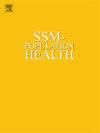南亚利桑那州美国/墨西哥边境墨西哥裔农场工人的社区环境、适应负荷和代谢功能障碍相关脂肪变性肝病之间的关系
IF 3.1
2区 医学
Q1 PUBLIC, ENVIRONMENTAL & OCCUPATIONAL HEALTH
引用次数: 0
摘要
背景:墨西哥裔农场工人患慢性疾病的比例高得不成比例,这增加了他们患代谢功能障碍相关脂肪变性肝病(MASLD)的风险。虽然已经发现社区水平的因素对健康的影响与个人水平的特征(包括适应负荷(ALoad))一样大,但这些因素在MASLD研究中得到的研究较少。本研究考察了感知邻里环境、ALoad和MASLD之间的关系。本研究也检视了ALoad是否为感知邻里情境与MASLD之间的中介。方法采用多元logistic回归和线性回归对居住在亚利桑那州南部边境地区的151名墨西哥裔农场工人的社区样本数据进行分析。收集社区环境六个维度的自我报告数据。计算适应负荷作为生理失调的指标。通过肝刚度测量(LSM)和纤维扫描(FibroScan®)控制衰减参数(CAP)评估肝脂肪变性和纤维化。MASLD被确定为CAP评分≥288 dB/m。结果平均年龄49.7±14.1岁,平均BMI为31.9±6.5 kg/m2, 9.9%患有2型糖尿病。平均CAP评分M = 265.8±61.0,41.1%的患者表现为MASLD状态。感知邻里暴力与MASLD状态无关;而与ALoad呈负相关(p = 0.003)。在感知暴力与MASLD状态之间,ad为负向中介(p = 0.004)。本研究的结果为制定与文化相关的策略提供了信息,以降低墨西哥裔农场工人患MASLD的风险,这些策略对塑造他们生活经历的结构性和系统性力量高度敏感。本文章由计算机程序翻译,如有差异,请以英文原文为准。
The association between neighborhood context, allostatic load, and metabolic dysfunction-associated steatosis liver disease in Mexican-origin farmworkers along the Southern Arizona US/Mexico border
Background
Mexican-origin farmworkers experience disproportionately high rates of chronic diseases which increase their risk for metabolic dysfunction-associated steatosis liver disease (MASLD). While it has been found that neighborhood-level factors influence health as much as individual-level characteristics, including allostatic load (ALoad), these factors have been less examined in MASLD research. This study examined the association between perceived neighborhood environment, ALoad, and MASLD. It also examined whether ALoad is a mediator between perceived neighborhood context and MASLD.
Methods
Multivariable binary logistic and linear regressions were fitted to analyze data from a community-based sample of 151 Mexican-origin farmworkers residing in the Southern Arizona border region. Self-reported data on six dimensions of neighborhood context was collected. Allostatic load was calculated as an index of physiological dysregulation. Hepatic steatosis and fibrosis were assessed by liver stiffness measurements (LSM) and controlled attenuation parameter (CAP) through FibroScan®. MASLD were identified as having a CAP score of ≥288 dB/m.
Results
The mean age was 49.7 ± 14.1 years, mean BMI 31.9 ± 6.5 kg/m2, and 9.9 % had type 2 diabetes. The mean CAP score was, M = 265.8 ± 61.0 with 41.1 % of the sample exhibiting MASLD status. Perceived neighborhood violence was not associated with MASLD status; however, it was negatively associated with ALoad, (p = 0.003). ALoad was a negative mediator between perceived violence and MASLD status (p = 0.004).
Conclusion
The results of this study inform the development of culturally relevant strategies to reduce Mexican-origin farmworkers’ risk for MASLD that are highly responsive to the structural and systemic forces that shape their lived experience.
求助全文
通过发布文献求助,成功后即可免费获取论文全文。
去求助
来源期刊

Ssm-Population Health
PUBLIC, ENVIRONMENTAL & OCCUPATIONAL HEALTH-
CiteScore
6.50
自引率
2.10%
发文量
298
审稿时长
101 days
期刊介绍:
SSM - Population Health. The new online only, open access, peer reviewed journal in all areas relating Social Science research to population health. SSM - Population Health shares the same Editors-in Chief and general approach to manuscripts as its sister journal, Social Science & Medicine. The journal takes a broad approach to the field especially welcoming interdisciplinary papers from across the Social Sciences and allied areas. SSM - Population Health offers an alternative outlet for work which might not be considered, or is classed as ''out of scope'' elsewhere, and prioritizes fast peer review and publication to the benefit of authors and readers. The journal welcomes all types of paper from traditional primary research articles, replication studies, short communications, methodological studies, instrument validation, opinion pieces, literature reviews, etc. SSM - Population Health also offers the opportunity to publish special issues or sections to reflect current interest and research in topical or developing areas. The journal fully supports authors wanting to present their research in an innovative fashion though the use of multimedia formats.
 求助内容:
求助内容: 应助结果提醒方式:
应助结果提醒方式:


